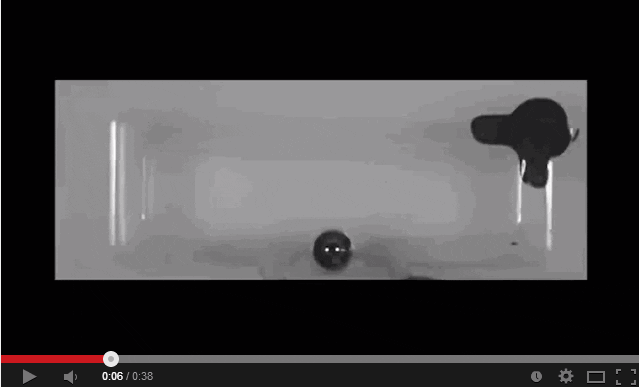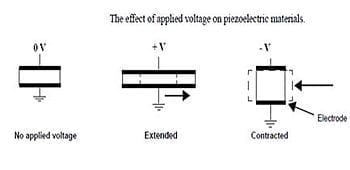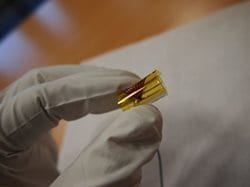
A revolutionary new micro-scale device with no mechanical parts.
RMIT University researchers in Melbourne, Australia, have developed the world’s first liquid metal enabled pump, a revolutionary new micro-scale device with no mechanical parts.
The unique design will enable micro-fluidics and lab-on-a-chip technology to finally realise their potential, with applications ranging from biomedicine to biofuels.
The research has been published this week in Proceedings of the National Academy of Sciences (PNAS).
Lead investigator Dr Khashayar Khoshmanesh, a Research Fellow in the Centre for Advanced Electronics and Sensors at RMIT, said currently there was no easy way to drive liquid around a fluidic chip in micro-fabricated systems.
“Lab-on-a-chip systems hold great promise for applications such as biosensing and blood analysis but they currently rely on cumbersome, large-scale external pumps, which significantly limit design possibilities,” he said.
“Our unique pump enabled by a single droplet of liquid metal can be easily integrated into a micro device, has no mechanical parts and is both energy efficient and easy to produce or replace.
“Just as integrated micro-electronics has revolutionised the way that we process information – enabling the development of computers and smart phones – integrated micro-fluidics has the potential to revolutionise the way we process chemicals and manipulate bio-particles at the micro-scale.
“This innovation shows that micro- and nano-scale pumping can be accomplished with a simple system – a crucial advance for the field of micro-fluidics.”
The design uses droplets of Galinstan – a non-toxic liquid metal alloy comprised of gallium, indium and tin – as the core of a pumping system to induce flows of liquid in looped channels.
When the alloy is activated by applying a voltage, the charge distribution along the surface is altered. This propels the surrounding liquid without moving the Galinstan droplet through the loop, using a process called “continuous electrowetting”.
The pump is highly controllable, with the flow rate adjusted simply by altering the frequency, magnitude and waveform of the applied signal. The flow direction can also be readily reversed by reversing the polarity of the applied voltage.
The Latest on: Microfluidics
[google_news title=”” keyword=”microfluidics” num_posts=”10″ blurb_length=”0″ show_thumb=”left”]
via Google News
The Latest on: Microfluidics
- Microfluidics Market Predicted Growth: USD 102.9 Billion by 2033, Growing at 12.3% CAGRon April 26, 2024 at 12:30 am
According to a recent report by Market.us, the Global Microfluidics Market size is expected to be worth around USD 102.9 Billion by 2033 from USD 32.3 Billion in 2023, growing at a CAGR of 12.3% ...
- Accessible Cell Therapies for Alzheimer's and Parkinson's Diseaseon April 25, 2024 at 10:21 pm
Researchers have now potentially advanced the accessible personalized cell-based therapies for Alzheimer's and Parkinson's diseases.
- Microfluidics Market CAGR of 22.9%, In the Participant’s Shoes A Glimpse into Effective Focus Group Dynamicson April 25, 2024 at 9:01 pm
Request To Download Free Sample of This Strategic Report @- Microfluidics Market is valued approximately USD 12.8 billion in 2019 and is anticipated to grow with a healthy growth rate of more than 22 ...
- CellFE Announces May 2024 Conference Presentationson April 25, 2024 at 10:44 am
CellFE Inc., a life sciences tools company with a novel microfluidics-based cellular engineering platform, announced today an upcoming presentation by CSO Todd Sulchek, PhD, at the American Society of ...
- Standard BioTools Announces Operational Restructuring Plan to Drive Long-Term Profitable Growthon April 25, 2024 at 5:45 am
Company expectsto achieve $45-$50 million in annualized operating expense savings in fiscal 2025Management to discuss first quarter 2024 ...
- New device improves stem cell generation and chance for accessible Alzheimer's cell therapyon April 24, 2024 at 12:11 pm
Researchers in Sweden say they have improved on a technique for converting regular skin cells into neural stem cells—an advance that they say helps close the gap for accessible personalized cell-based ...
- New research demonstrates potential of thin-film electronics for flexible chip designon April 24, 2024 at 8:00 am
The mass production of conventional silicon chips relies on a successful business model with large "semiconductor fabrication plants" or "foundries." New research by KU Leuven and imec shows that this ...
- New disease models unlocking secrets to neurological researchon April 23, 2024 at 9:28 am
Another major technological advancement has been the proliferation of microfluidic devices, which contain a small chip, imprinted with very small channels and reaction chambers, that uses forces such ...
- Global Microfluidics Market Size To Worth USD 65.90 Billion By 2033 | CAGR Of 7.36%on April 23, 2024 at 5:00 am
The Global Microfluidics Market Size was Valued at USD 32.40 Billion in 2023 and the Worldwide Microfluidics Market Size is Expected to Reach USD 65.90 Billion by 2033, according to a research report ...
- What Does DNA Stand For, and How Does It Work?on April 21, 2024 at 5:00 am
DNA is the molecular basis of heredity, the inherited traits that pass between generations in a person's family tree. Embodied in the sequence of base pairs, DNA carries information between ...
via Bing News










